Best Ice Axes and Tools for Winter Climbing and Mountaineering
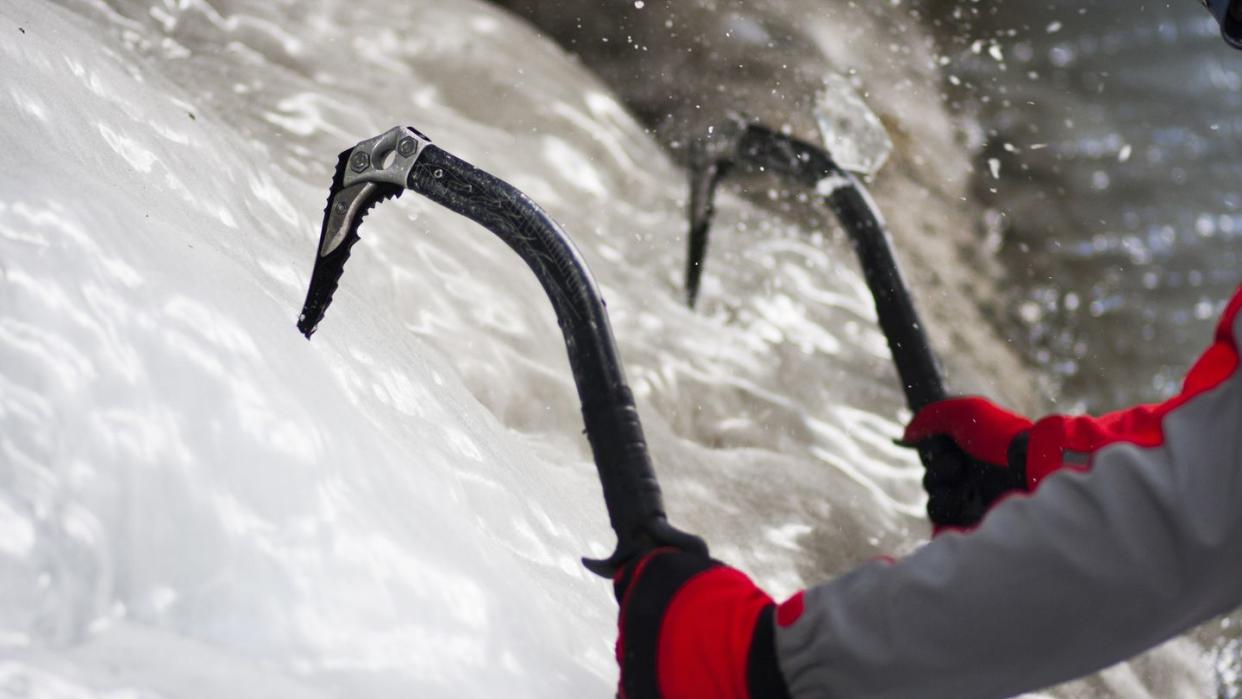
"Hearst Magazines and Yahoo may earn commission or revenue on some items through these links."
When venturing into the backcountry in winter and even into the shoulder seasons of late fall and early spring, an ice axe is a vital tool for navigating steep snow fields, ice, and scrambles. However, the right one varies greatly depending on your needs. The ice axe you’ll want to use for mountaineering and couloir climbs is different than the type of ice tools you’ll need for pure ice climbing. A ski mountaineer or scrambler will have different needs as well.
Here’s what you need to know when choosing ice tools, along with my favorite picks for the best ice axes. With one of these, you can literally take your winter adventures to new heights.
The Best Ice Axes and Tools
Best Mountaineering Axe: Petzl Summit Evo Ice Axe
Best Value Technical Ice Tool: Trango Raptor Ice Axe
Best Value Mountaineering Axe: Grivel G1 Ice Axe
Best Size Range in Mountaineering Axes: Black Diamond Raven Ice Axe
Lightest Ski Mountaineering Axe: C.A.M.P. Corsa Race Ice Axe
The Expert: When the temps drop and the powder starts falling, I know it’s time to break out some of my favorite gear of the year—skis, ice axes and tools, crampons, extra layers—and hit the peaks and icefalls. I’ve written about the outdoors and tested gear for well over a decade for publications including Backpacker, Treeline Review, Bicycling, and 5280. I’ve authored books about adventures in Colorado and climbing its iconic 14ers for Falcon Guides and providing mapping information for National Geographic. I love testing gear in the winter and using it in untouched snowscapes and on frozen falls, and then relating my experiences to readers to help them make the best, most informed choices they can when choosing their own gear.
What to Look for in an Ice Axe
The biggest distinction is between ice axes (used for mountaineering and hiking) and ice tools (used for ice climbing). Both are axes used for cold weather adventures. After that, there are a lot of differences, from ultralight, short axes used for ski mountaineering and scramblers, to traditional mountaineering axes used for couloir climbs, self-arresting, and glacial travel.
Ice axes, like crampons, have many different uses, and as such, they’re highly specialized to meet the needs of various demands. What’s commonly considered an ice axe is actually a mountaineering axe. It has a longer shaft than an ice tool, and a spike on the bottom that’s used for plunging the tool into snow and ice to give you extra purchase while traversing difficult snow and ice terrain. While ice climbing requires two ice tools, you usually only carry one ice axe.
The fixed head of the axe features a pick and usually a horizontal adze. These are used for climbing and traversing, digging snow anchors and glissading. Mountaineering axes are available in a variety of lengths (ideally the tip of the spike is at or just above your ankle when held at your side) and are generally used on the high side of a slope when mountaineering. They’re typically not meant to sustain your full weight while climbing more vertical surfaces such as a waterfall.
What to Look for in an Ice Tool
Ice tools are designed for more rigorous abuse; you can hang your full weight on them—vertically and horizontally—and they’re used in pairs. Some ice tools are designed for mixed climbing (rock and ice) while others are engineered more specifically for ice climbing. They’re shorter and often more curved.
The head of the shaft is reinforced, and the pick is made of stiff, strong steel. An ice tool is designed to be repeatedly swung into ice and won’t be damaged when it strikes rock or other materials as well.
Many ice tools are also more multifunctional than mountaineering axes because they have heads where the picks can be replaced and other items—hammers and adzes, for instance—can be added. You can also easily tell the difference between the two in terms of price. Decent mountaineering axes are available for under $100, while most ice tools cost more than $200—each.
More to Consider in an Ice Axe or Ice Tool
Weight
Every ounce counts in ice axes and ice tools, but lighter isn’t always better. Most light ice axes are made of aluminum throughout, and an aluminum head and pick will wear out quickly. While weight is a chief everyday concern, keep in mind that an aluminum tool likely can’t handle your body weight reliably in a serious self-arrest.
For ice climbing, the weight of the head and pick can actually help enhance your swing, but if the pick and axe are too heavy, they will tire out your arm more quickly. As such, the range of weights per ice axe recommended here varies from less than half a pound to about 1 pound and 6 ounces for some ice tools.
Head
The head of the ice axe or tool is what you’ll want to pay most attention to when making a purchase. The head consists of the pick on one side and, depending on the axe or tool, the other end can have an adze, hammer, or nothing at all.
Most mountaineering axes have adzes for digging snow trenches. Ice tools may have a hammer or nothing on the other end. The hammer can help the user put a piton in or be used to clear away rotten rock or ice in some situations.
Length
Ice tools for ice climbing are almost always available in only one shaft length; same with most axes intended for hikers and scramblers. The reason is because they’re intended first and foremost for climbing upward and for swinging the axe to gain purchase in ice or rock.
Mountaineering ice axes have different lengths because they’re used when hiking across glaciers and across steep slopes as well as for some vertical climbing. They’re designed for thrusting into snow and ice on the upslope side of the body. The shaft length varies based on the user’s height and arm length. That’s why some, like Black Diamond’s Raven, are available with shaft lengths from 55 cm to 70 cm.
The traditional rule of thumb for sizing a mountaineering ice axe is to hold it by the center of the head with your arm down at your side. The spike of the axe should dangle at your ankle. That will ensure that when you’re hiking across a slope with your mountaineering axe on the uphill side that it won’t cause extra shoulder fatigue by forcing you to keep your shoulder lifted.
Material
Ice axes and ice tools are made of multiple materials but primarily aluminum and steel. Typically, aluminum is used for the shaft of the ice axe or tool and steel is used for the head. Some of the more commonly used ice tools have removable picks and accessories including an adze or hammer attachment.
There are outliers, of course, like ultralight mountaineering axes that are likely made completely from aluminum—including the axe head. Yes, this makes them light, but significantly less durable and less able to carry the full weight of a mountaineer in a hard fall. Likewise, some ice tools save weight with a carbon fiber shaft. This makes them lighter, but also significantly more expensive.
How We Selected Ice Axes and Ice Tools
I chose these ice axes and tools after using them in field, consulting with other ice climbers and mountaineers about their favorites, and checking expert reviews from leading outdoor publications like OutdoorGearLab, Gripped, and others. I considered the needs of mountaineers, hikers, and scramblers who may encounter snow fields on excursions, and how the height of a user will impact the size of ice axe they need.
In mountaineering and ice climbing, where your life depends on the gear you use, quality is paramount. That’s why I considered products—pick styles and axe options—from leading brands with great reputations. These include Black Diamond, CAMP US, Cassin, Grivel, and Petzl.
When it comes to mountaineering axes, the main option is the length of the shaft. When it comes to ice tools, there are more options to consider, including the curvature of the shaft, multiple hand hold options and interchangeable pick heads, and the ability to add hammers, adzes, or weights to the head to adapt the tools to the users’ skills and needs.
If you’re in search of other climbing or winter gear, check out these articles: The Best Men’s Snow Pants for Skiing, Boarding, and Winter Adventures, 10 Best Thermal Gloves for Winter Adventures.
Summit Evo Ice Axe
The Petzl Summit Evo is a versatile mountaineering axe for alpine climbing. Though designed primarily for technical mountaineering, it also shines in hiking and glacial travel.
The aluminum shaft is slightly angled so it's easy to swing or place the pick of the fixed steel head over any rock or ice bulges when climbing gullies. The spike easily penetrates ice-crusted snow while traversing snow and ice fields.
The rubberized grip at the base of the shaft makes it accessible to grasp with gloves of any size. Available in three lengths, the Summit Evo is an ideal, somewhat aggressive, mountaineering axe.
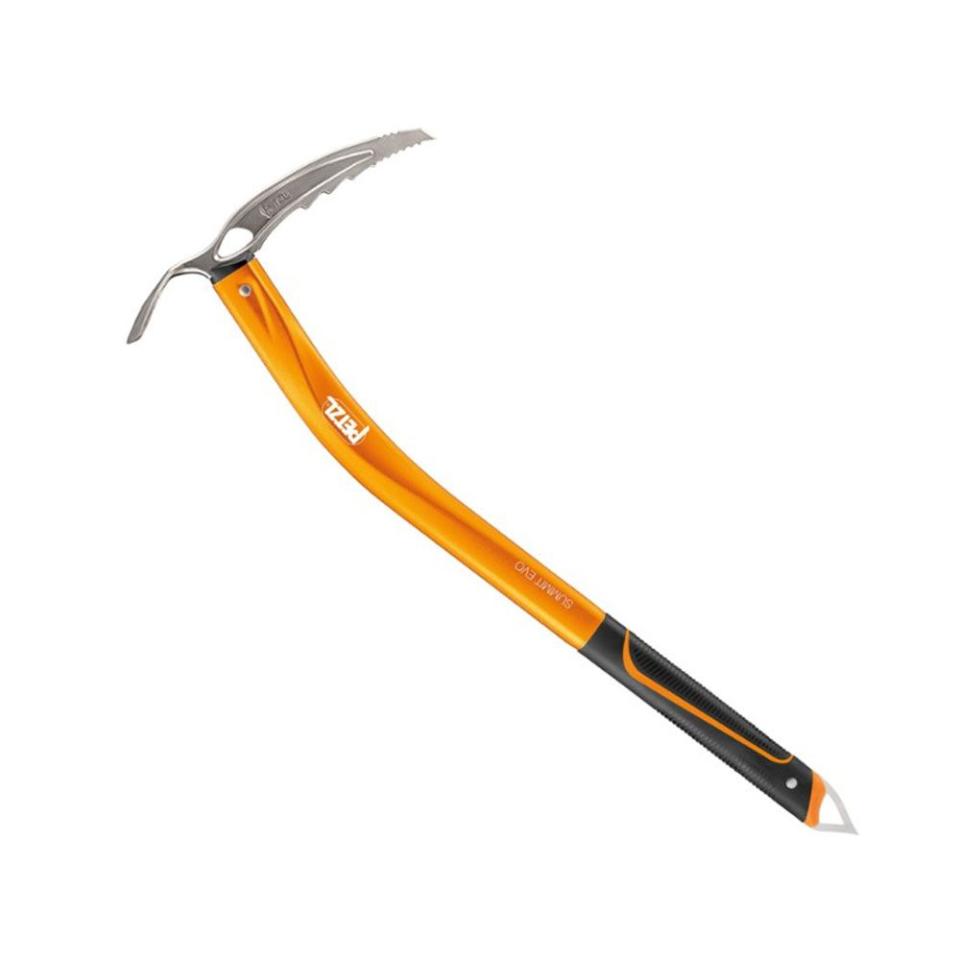
Summit Evo Ice Axe
rei.com
$159.95
Raptor Ice Axe
It might sound silly to call a tool that sells for close to $200 inexpensive—especially considering you need two, but the Trango Raptor punches above its weight. This ice tool is at home on steep ice climbs and can handle some moderate mixed climbing.
The Raptor comes with removable pick weights and users can add adzes or hammers to the back of the tools for cleaning snow and debris, building a belay station, or hammering in pitons or starting ice screws and pro.
The handle has two rubberized grips for multiple hand positions and is thinner than that of many other ice tools, which makes it ideal for smaller hands.
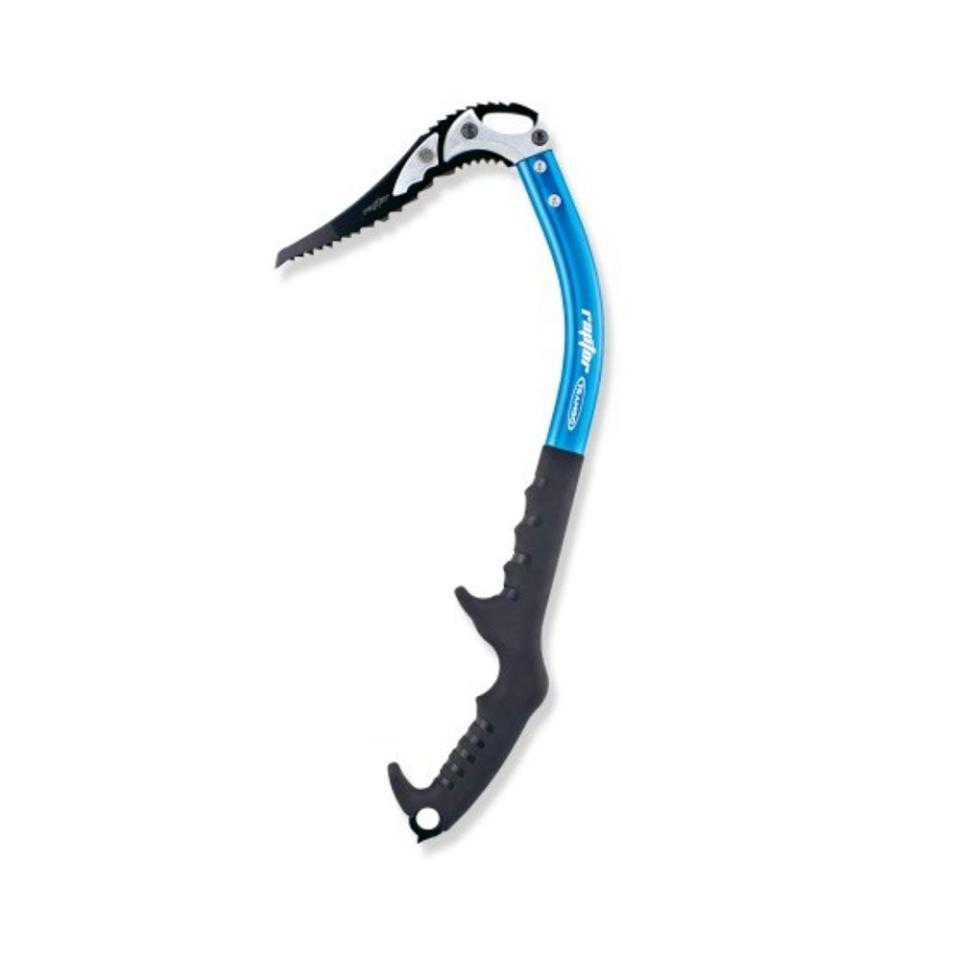
Raptor Ice Axe
rei.com
$189.95
G1 Ice Axe
The Grivel G1 mountaineering axe offers one of the best values for an ice axe that I’ve seen. It’s a simple, classic mountaineering axe with a steel head and above average pick, and an adze that allows for great self-arresting capabilities. It’s also good for cutting steps and placing snow anchors.
The G1 is available in three sizes and with some other options. It’s a great overall mountaineering axe that’s ideal for mountain climbing and glacial travel.
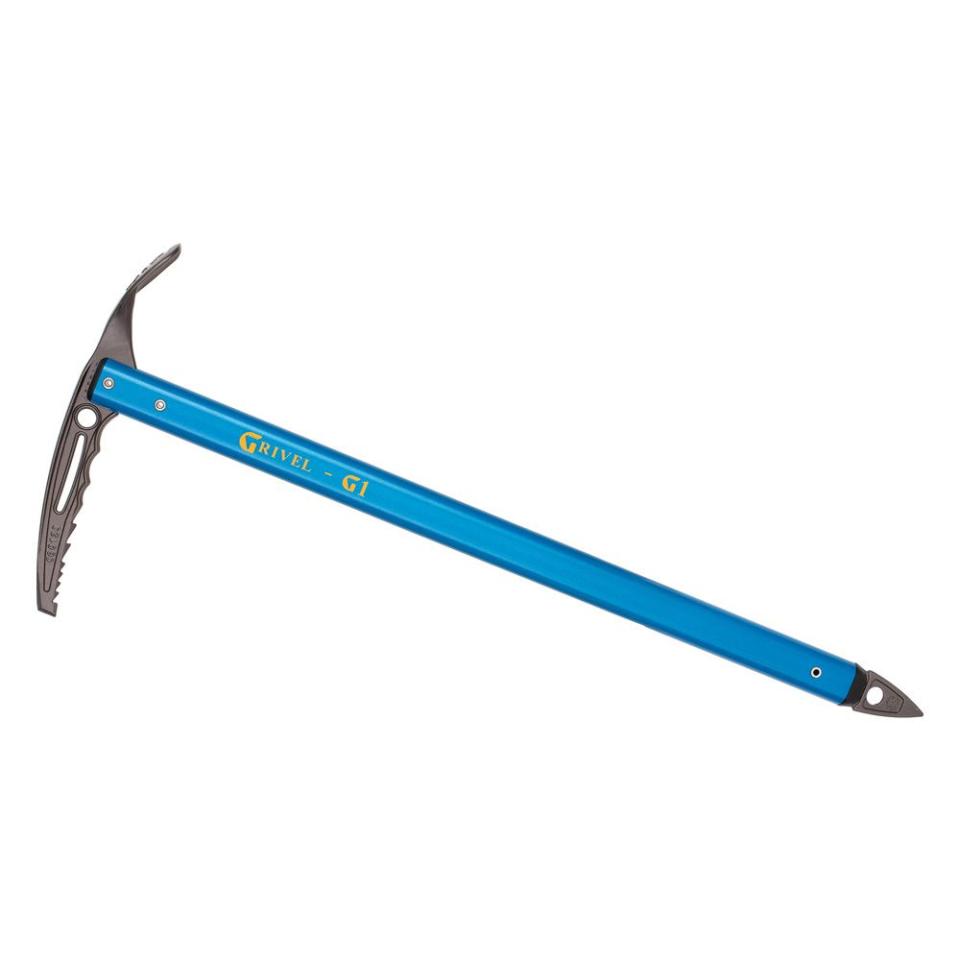
G1 Ice Axe
rei.com
$58.93
Raven Ice Axe
If you want a classic mountaineering axe, look no further than the Black Diamond Raven Ice Axe. Available in seven shaft lengths, the Raven can accommodate shorter folks and kids to those who are upwards of 7 feet tall.
The Raven’s design is reminiscent of the axes that grace the doors of almost every REI across the country, but is upgraded with an aluminum shaft to reduce weight and increase durability. The Raven’s fixed head is stainless steel, and its wider middle easily accommodates your gloved hand.
Built for mountaineering, glacial travel, and alpine trekking, the Raven isn not suitable as a technical mountaineering axe for steep climbs.

Raven Ice Axe
backcountry.com
$89.95
Corsa Race Ice Axe
This one’s for the gram counters, the hikers, and scramblers who need a minimalist mountaineering axe for steep, vertical climbs that stows away to nothing in a pack.
C.A.M.P. claims the Corsa Race is the lightest-rated ice axe out there. With a shaft just under 20 inches long, it’s a short ice axe designed with ski mountaineering in mind. To reduce weight to a scant 6.5 ounces and increase grip, C.A.M.P. machined holes in the shaft’s grip.
The manufacturer has also turned to 7075 aluminum for the pick material rather than steel. That means the pick and adzes aren’t as durable and don’t carry the same type of head weight and swinging weight that other mountaineering axes do. Still, this was an ISPO Gold Award Winner in 2020.

Corsa Race Ice Axe
rei.com
$159.95
Nomic
This is my tool of choice even though I have the previous model. The Nomic is a popular ice tool for many reasons.
For starters, the adjustable grip rest makes it easy to accommodate hands of different sizes. A secondary upper hand grip and rest allows climbers to securely grip it with one or two hands, which makes matching hands and transitions to the other tool easier. The Nomic is well balanced, making swings thunk into the ice with ease.
The Nomic also comes with a hammer opposite the pick, which allows climbers to hammer in pitons and clear rotten ice when needed.
The Nomic is part of Petzl’s Alpen Adapt System, which means there’s a full line of accessories for the tool, including additional picks for mixed climbing and dry tooling on rock, as well as additional handsets, adzes, and more.

Nomic
amazon.com
$319.95
Reactor
Another fantastic all-ice tool, the Black Diamond Reactor, comes with the Black Diamond Natural Ice Pick, but climbers can change it out for a number of other picks for ice and mixed climbing as well as alpine endeavors.
Climbers can also add hammers and adzes as needed. The short shaft length and aggressive curve of the handle make this tool more ideal for ice climbing than alpine days.
With a slightly shorter and thinner pick than some other options, the Reactor slices in with splitting off less chunks. The double handle is well offset and can adjust for multiple hand sizes and allows for matching hands while climbing steep ice.

Reactor
rei.com
$299.95
Ergonomic Ice Tool
The Ergonomic is Petzl’s most aggressive tool intended for difficult ice climbing and dry tooling. The company introduced the tool to replace the Ergo in 2018, the same year it revamped the Nomic.
Like the Nomic, this is part of the Alpen Adapt group, allowing climbers to change picks, hammers, and adzes out as desired.
This comes with Petzl’s thicker dry tooling pick for hooking and slotting on rock, as well as a hammer and pick weights. The double handle has an adjustable pinkie rest to allow for multiple hand sizes. The handle is more offset than on the Nomic and Reactor for dry tooling as well.
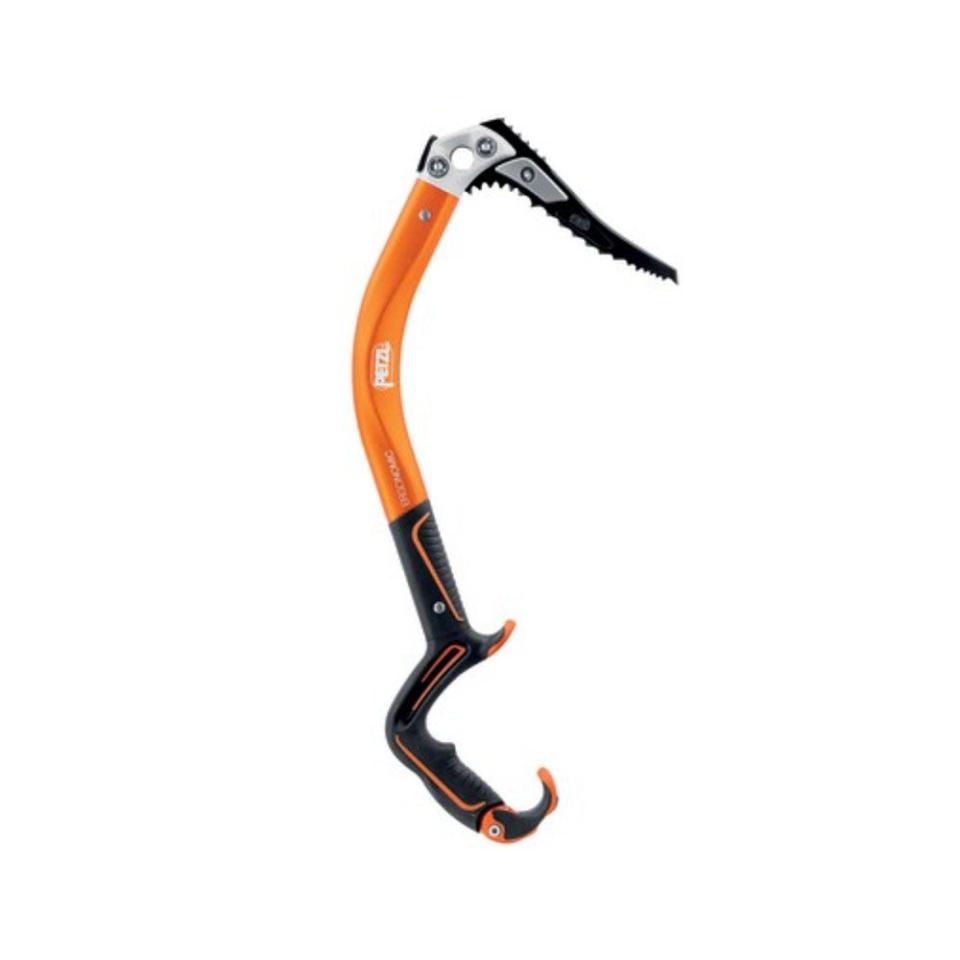
Ergonomic Ice Tool
backcountry.com
$370.00
Dark Machine
This is the only actual ice tool recommended here—made primarily out of carbon composite and carbon fiber—and is also the most expensive tool in this roundup.
The construction results in a lightweight tool that’s still well-balanced and cuts into ice easily. The low weight means you may have to swing the axe a little harder to sink it into ice, but the weight of the head helps offset the need to swing it too hard.
The Dark Machine and its cousin, the Dark Machine X (intended for mixed climbing and dry tooling), have carbon fiber handles that climbers have to wrap with tape for extra grip or handle customization. The tools are in Grivel’s Vario line, which allows climbers to switch picks out for different conditions and add hammers and adzes as needed.
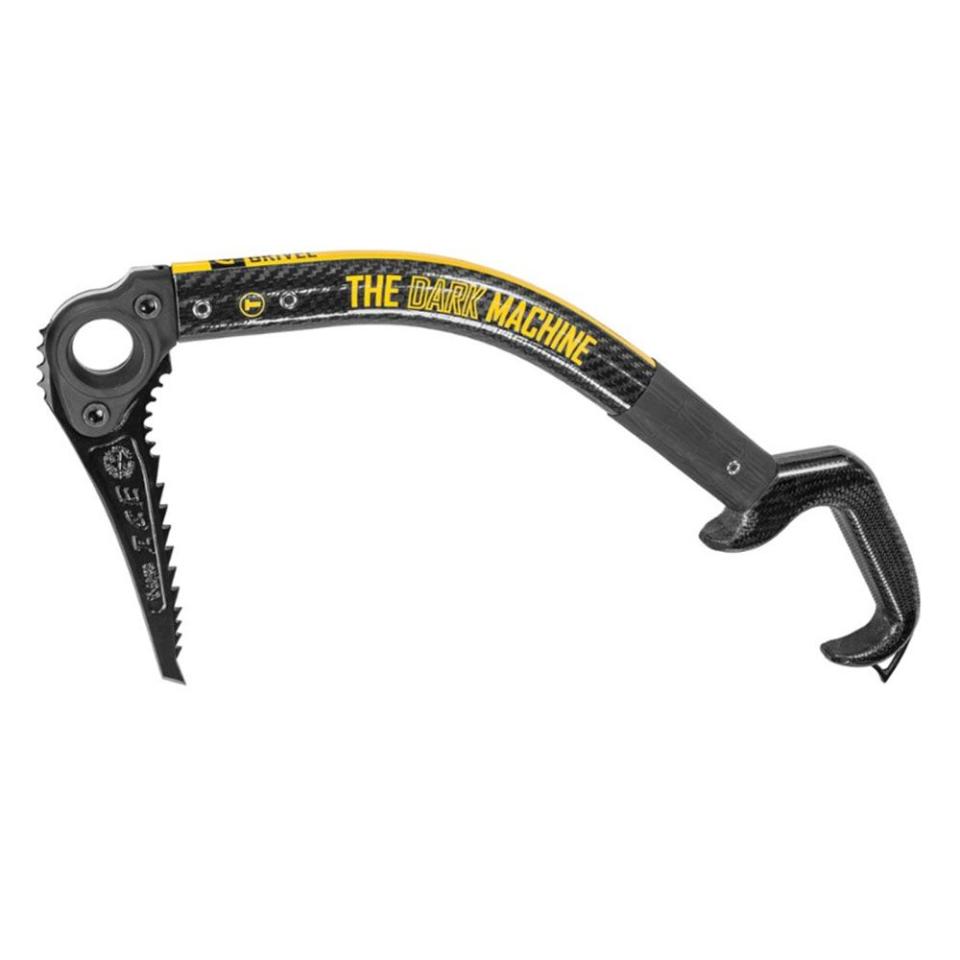
Dark Machine
rei.com
$419.95
Whippet Ski Pole
Though not technically an ice axe, Black Diamond’s Whippet is a versatile ski mountaineering and light mountaineering tool that allows you to self-arrest on steep snow climbs—and it doubles as a trekking pole. It’s also ideal for scramblers and hikers for this reason with trekking pole capabilities while the pick is removable for easier hikes.
The whippet collapses down to just over 2 feet and telescopes up to over 4 feet long, which makes it ideal as a trekking pole and mountaineering tool for shorter, young adults up to individuals well over 6 feet tall.
Previously, I had recommended the carbon fiber version of the Whippet. However, of late, I have heard of multiple instances where some of Black Diamond’s carbon fiber trekking poles have had problems. (We've reached out to Black Diamond to comment on concerns related to its carbon fiber, and will update this article if/when the brand responds.)
The weight savings between the carbon fiber and aluminum versions is minimal, less than 10 grams. Additionally, the cost of the aluminum one is about $40 less, and it collapses to a shorter length, adding more versatility to the tool.
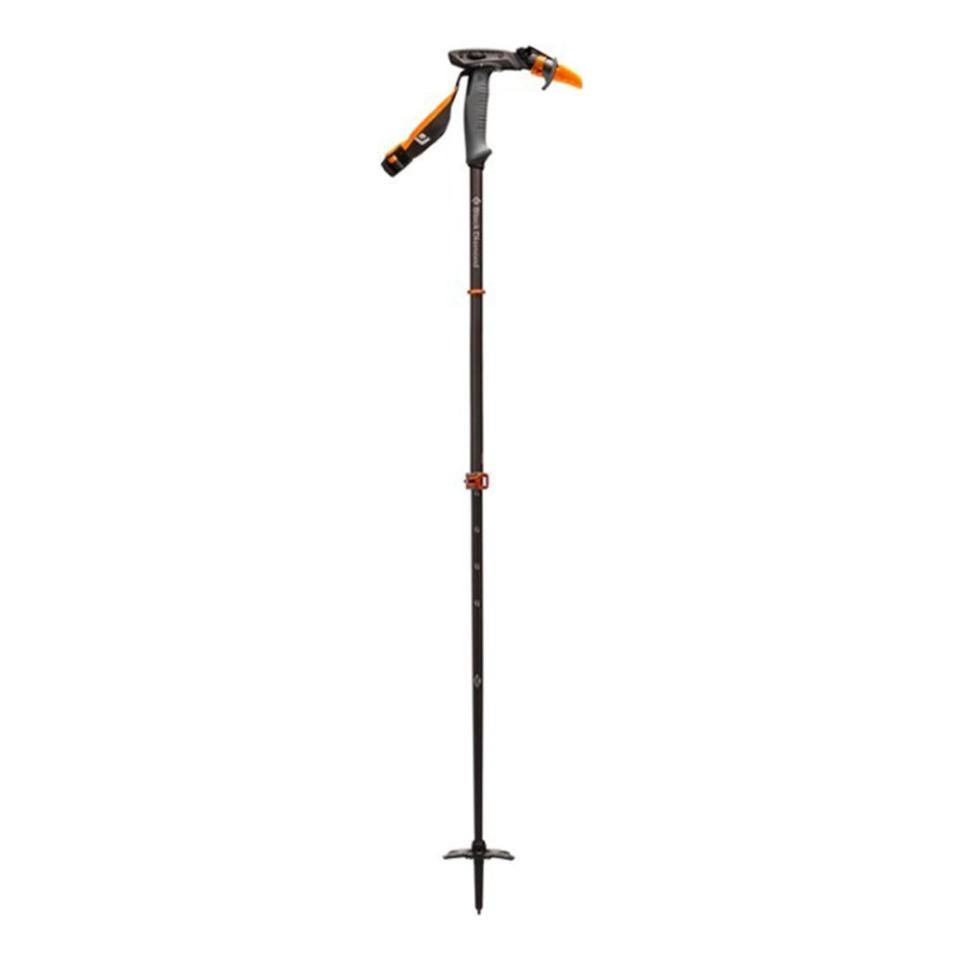
Whippet Ski Pole
rei.com
$150.00
How Many Axes Do You Really Need Plus Leashes, Lengths, and Curves. Expert Chris Meehan Shares Essential Info Before You Buy.
Is there a rule of thumb for choosing the length of an ice axe?
Somewhat. For general mountaineering, choose an axe with a bottom spike that hovers around your ankle when you hold it by the axe head with your shoulders in a neutral position. For most people this ranges between 55 cm and 65 cm.
For other purposes, like ice climbing, the ice tools are generally shorter, around 40- to 45 cm from head to spike. For thru-hikers who need an axe for early or late season scrambles, they can usually get away with an ice axe that’s 10 cm shorter than a mountaineer’s ice axe.
Neutral, reverse and positive curves—what do I need to know?
This refers to the shape of the pick on an ice axe. The majority of mountaineering ice axes have what’s called a positive curve where the pick arcs downward from the head of the shaft slightly. This type of axe is excellent for gripping into snow on steep slopes and for self-arresting.
Some mountaineering ice axes have a more neutral, or flat pick, meaning they’re relatively flat across the head of the axe. These are great for self-arresting but not as good when climbing on steep snow.
Reverse curved picks are more often found on tools used for ice climbing or mixed climbing. They curve downward from the head of the axe and then reverse that curve slightly, making the end of the pick flatter.
These are used primarily in ice tools and axes made for steep ascents. The reverse curve at the end of the pick makes it easier to place the ice tool as well as pull it out when it’s time to place in the next spot. They aren’t ideal for self-arresting on softer materials like snow because they’re designed to hold closer to the tip of the pick rather than across the full blade of the pick.
Is it possible that I need more than one ice axe/tool?
Yes, depending on your activities. If you’re into general mountaineering, you really only need one—a mountaineering ice axe. If you’re an ice climber, you’ll need two ice tools or climbing axes.
How many ice axes do you own?
Currently, I have three. I could see the need for having two more specialized ice axes like a short ice axe for scrambles and hikes and a whippet for hikes where some extra snow traction might be needed.
Should I have a leash for my axe?
For a mountaineering axe, it’s good to have one in case you drop it on a steep slope as it’ll keep you from losing it, and such leashes easily transition to either wrist.
If you’re learning to ice climb and getting familiar with using ice tools, it’s nice to have a double leash. Such a leash attaches to both tools via your climbing harness, so if you drop one it won’t hit anyone below and you can retrieve it easily.
However, the leashes are sometimes cumbersome because as you climb you may change which hand uses which tool. This can lead to wrapping the individual leash around each other, shortening the leashes and complicating your freedom to place the ice tools.

You Might Also Like

